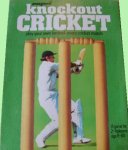
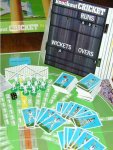
| Peter Upton's |
Subbuteo Tribute Website. |
|
Old Figures - New Games. |
Part Two: Cricket Games. |
One of the most valuable possessions of any plastic kit manufacturer are the original moulds. As Airfix production over the last thirty years has shown, these moulds can have a long life if they are looked after properly. Of course this life span gives the moulds a high value, and there are many examples of them being sold between companies, allowing old forgotten kits to live again.
The same thing seems to have happened to Subbuteo's 1970s moulds. One of the most appealing features of Subbuteo was the quality of the figures produced. The lovely cricket figures have gone on to lead a life of their own.....


Capri Knockout cricket was a mid-1970s board-game, which looked to cash-in on the new "limited overs" version of cricket. (The rules were copyright 1976).
All the action took place using two packs of cards and a die. The bowler would start by taking the top six cards from the bowling card pack. He was allowed to exchange one if he wanted, and could bowl them in any order. Once he had seen the cards, he could set up the fielders. Once set up, he could then only move two fielders during the over. The bowler cards usually had two pieces of information on them representing line and length i.e. "Outside Leg Stump/Full Toss".
The batsman was allowed twelve batting cards in response. These could be sorted into "defensive", "off-side" and "leg-side" cards. These cards also had two pieces of information on them, showing which balls you could use the card against, and the resulting shot. So you might get "outside leg stump. Good length/Leg glance to deep fine leg". Once a batting card was used the batsman replaced it, so he always had twelve cards.
There were a couple of special balls for the bowler, the "yorker" and and "bumper and beamer". Both needed a special batsman card to negate. The yorker lead directly to a bowler appeal, and the bumper forced the batsman to play with one less batting card until a wicket fell.
The die was used to determine the number of runs for each shot. If the number and direction matched to a fielder, then the batsman was caught. There were also bowler appeal cards, wicket-keeper cards (byes and stumping), and fielder appeal cards for run-outs.
Of course, from a Subbuteo point of view, the key component are the playing pieces used to represent batsman and fielders, which are the same design as a certain game we know....
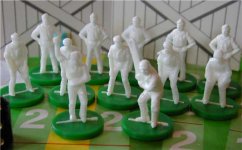
The other components aren't up to Subbuteo standards sadly. The sightscreens and the (admittedly huge) scoreboard are only made of card. thanks to Ian Moore for providing the photos and info on this game.
Capri also produced a couple of companion games for this set, including an athletics set, and a mountaineering game. Sadly, the plastic pieces in these sets are a much poorer quality than the lovely Subbuteo fielders.
Wicketz.
"The most authentic cricket board
game ever."
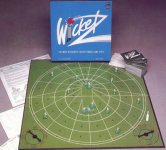
This entertaining game was produced by RDA Marketing, and like Capri cricket, was a board game, rather than the action game that Subbuteo produced. The game was played on a standard square board showing a circular cricket pitch divided into sections, along with two spinners and a bowling indicator. The other components were a large pack of batting cards and the cricket figures, which like Capri Knockout cricket look a little familiar....

The game is great fun to play, and the basics are easy to pick up. The bowling side places his fielders into sections of the field, and then spins the bowling indicator to produce a delivery. Some are good deliveries, and some are poor. The batsmen then uses this information to decide which type of shot to play. There are nine attacking shots in various directions, and four defensive shots. Once he has announced his shot, the batsman turns over the top batting card, and reads the results. Depending on the type of ball, the type of shot, and the field placing, there is a chance of runs, or a wicket. If the player is called out, then he still has a chance with the "out/not out" spinner. Batting is entertaining and a little nerve wracking, but bowling can be a bit tedious - just a case of spinning the indicator, and moving fielders now and again. At least the advantage of this is that it makes for great solo play.
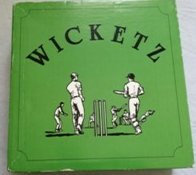
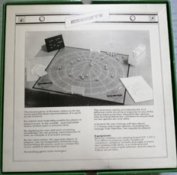
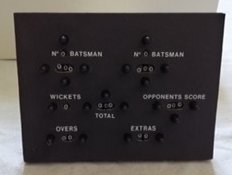
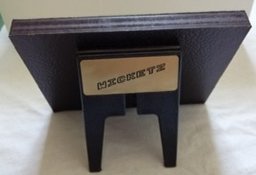
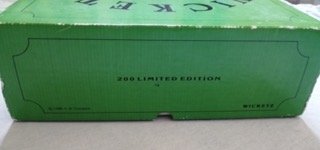
There were several versions of Wicketz produced. Website visitor Brian Middleton has advised me that the first edition of Wicketz was actually a special limited run of 200 sets, sold prior to full production in 1988. This version had cards printed and hand-cut by the inventor and his son. It also featured a fantastic scoreboard, which was deleted from the main run of the game simply because of the high cost of production. Whilst the box looks similar to the 1988 version, Brian tells me that it is a lot deeper (I assume to allow for the scoreboard). The set also had an article from the designer explaining how the game came about.
(A big thank you to Brian for the information and the pictures of this early version).
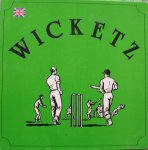
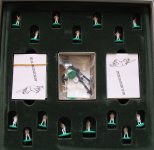
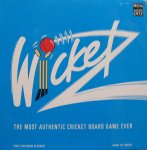

The first full production "green box" version shown on the left was copyright 1988, and still had a basic feel to cards and rule sheet. The rules had been tweaked from the original set. You can see that the cards were still rather plain. The blue box set on the right is one of a pair of sets copyright 1994, which had an improved logo and more of a professional sheen to the components. The cards now had an attractive backing, and the rules sheet had new cartoon illustrations.
As mentioned, the 1994 version of the game was produced in two versions. The blue box illustrated was the basic set, and featured a plain plastic inner, with all the components stored in the three hollows in the middle of the box. The players in this set were supplied unpainted. The deluxe set had a green box. This is not illustrated, but imagine the blue box in the colour of the cards. This had painted players laid out as they were in the original set.
My original green set also had a set of (Subbuteo mould) sight-screens included, and the basic blue box set does not have these.
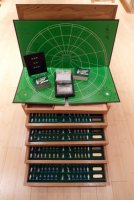
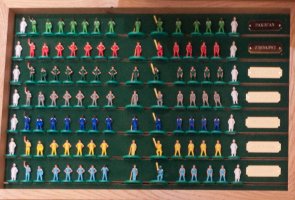
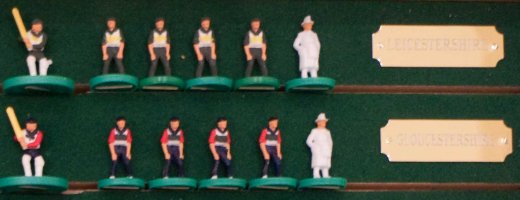
The other Wicketz set worth mentioning is this giant wooden edition. A seriously limited edition set (it may have even been partly promotional), it came in a lovely wooden cabinet with four drawers, each containing seven painted county and/or international sides. Each side has a "brass" name plaque next to the team. The rules and cards date this with the mid-1990s sets. It is a thing of beauty.
August 2021: I found some more pictures of the set in my files. On the left is a tray of International sides (Pakistan and Zimbabwe are the top two), and on the right is a close-up of the finely detailed paint work on the county sides (here, Leicestershire and Gloucestershire).
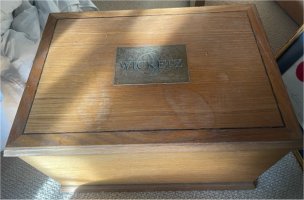
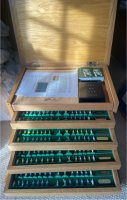
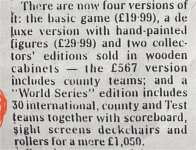
April 2024: I was sent further pictures of a deluxe set of Wicketz late last year, along with a newspaper article from the Daily Telegraph for Saturday 16th March 1996, which showed cricket fans Sir Tim Rice and Mike Read playing the game. The article by Steve Jackson included further details of the history of the game and the various editions that exist. The story in the Telegraph is that inventor Alf Compton produced a limited run of 500 copies in 1988. When demand exceeded this supply, the inventor realised there was a gap in the market for a cricket board game, and so he contacted RDA Games (of Woking, Surrey) to publish the game on a wider scale. Does that mean the limited run was 200 sets, and there were 500 of the first green set?
As the quote from the newspaper shows, the RDA versions were priced at £19.99 and £29.99, and the wooden cabinet version also had two expensive editions for the seriously deluxe market. The article explains that Mike Read had ordered a deluxe set for Sir Tim Rice's birthday, but I can't imagine they sold too many of them to be honest. The two wooden versions now shown on this site look identical, and have the international teams among the drawers, so I'm assuming they are both the full £1050 set. Whether the £567 version had one drawer or two, well I guess we'll have to wait for more pictures for that one.
The article also mentions a version on display "at the Lord Taverner's bar on board the P&O cruise ship Oriana". This was "housed in a beautiful floodlit cabinet", and was regarded as a prestigious one-off set.
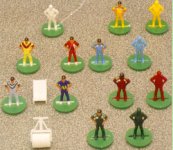
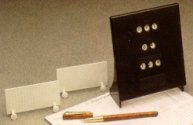
As I've mentioned, the Subbuteo connection is with the figures of course. The sets used all the types of fielder, batsman and umpire. The figures were perhaps not as fine castings as the originals, but they are pretty close. In a clever touch each batsman had an extra rotating ring around his base, which was used to indicate their batting position from one to eleven.
The sets included a flyer offering the chance to buy extra teams and accessories. You could buy the figures in different colour plastics, or hand-painted in international and county sides. The pictures here hopefully shows how nice the players look. RDA Marketing also sold the Subbuteo sight-screens, deck chairs, roller (but not the people pulling it) and the scoreboard, the latter being recast in black plastic with the Subbuteo logo covered with a Wicketz one.
RDA Marketing offered the following extras:-
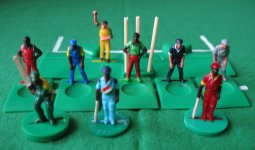
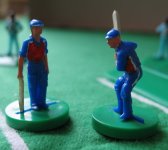
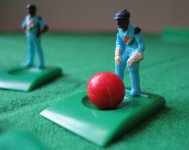
The Wicketz players were sold in a variety of different coloured plastics, allowing one-day sides to be quickly and easily painted. The plastic colours I've seen are red, dark red, green, dark green, blue, light blue, yellow, grey, and an odd purple/navy.
The problem for anyone looking for extra Subbuteo cricketers is that the fielders were not on catching bases. However, the players were available loose, and can be used if you can successfully remove broken Subbuteo cricketers from their bases (hot water and a screwdriver are recommended). As shown here, these figures can brighten up a game of Subbuteo cricket very successfully.
The Wicketz game had a promotional website that overlapped with the start of my site in the late 1990s, but I believe game production/promotion stopped at some point in the early 2000s, which is sad. It deserved more success than that. The inventor did have an overstock of spare cricketers in a range of colours in the early 2000s, both painted and unpainted. Some teams was sold through the Subbuteo websites of the time (That's Magnificent and Subbuteoworld both had stock at different times).
Anchorman Table Cricket.

This was a true clone of Subbuteo cricket made exclusively for Tom Taylor's Welsh table soccer shop - Peldroed Borth. The game was sold in a long thin black box, priced at £34.99 for the standard unpainted set. You could have a "whites" painted set for £39.99, a County one day set for £44.99 and a "Lewis International set" for £49.99. Colin Lewis painted the Tom Taylor deluxe team range in football, so I imagine this set would have featured teams similar to the painted Wicketz teams shown above.
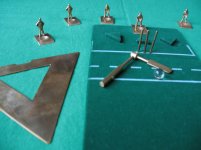
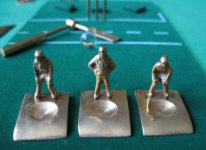
Anchorman was made in India, and probably the most unusual thing about it is that most of the components, including the figures, bases, bats, and the measuring triangle were made from brass.
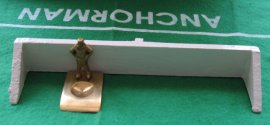
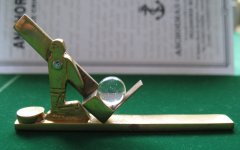
The playing surface was a lovely baize, matching the rectangular Subbuteo version. This was designed so it was easy to play on a standard table soccer board (which Tom Taylor's shop also produced). The actual bowling strip was a piece of wood covered in cloth, into which the brass stumps were placed directly. Whilst the fielders were a brass copy of the Subbuteo set, the bowler was a new and improved design as shown above. Another innovation were the fielder extensions, which represented the reach of the boundary fielders more realistically. These were of a simple (but effective) wooden design, and one could also be used as the wicket-keeper stop as provided in the Subbuteo version.
The more robust nature of the pieces meant that a glass ball, like a small marble could be used instead of the plastic Subbuteo ball. I'm not sure how dangerous this makes hitting a big six....
Tom's son Algy advises me that a few separate painted cricket teams were produced alongside the set. A "catalogue list" was produced, but not all the teams were ever painted. Some were simply never ordered, and "not seen as being likely to sell from the shop". They produced one-day kits for all the full-member national teams for the 2007 World Cup (in the West Indies), and had hoped to sell sets at the event (but the expense proved too much sadly). Scotland was also produced and popular.
The one-day kits for the counties were the other part of the catalogue list, but Algy isn't sure of which ended up being produced. He is sure that Warwickshire, Gloucestershire, Lancashire, Kent, and Northamptonshire were painted, and maybe Derbyshire. The Woodentop catalogue I have shows Essex. Perhaps some old shop customers can help out the site with photos.
The team sets included 10 fielders, a bowler, and a single bat. The bat was unpainted.
I own a catalogue from January 2005 which gives the team prices as follows:-
Algy also mentions that "Other accessories available were the plain brass bowler on its own, the bats on their own, glass balls (painted either white or red), and the fielder boundary extensions. The boundary extensions had been developed over a number of years of playing Subbuteo cricket competitions at Lichfield Subbuteo Club over the summer months." Indeed, the reason for the set in the first place was because Subbuteo cricket spares were getting hard to source, so that is why all the separate parts were made available from the shop. Tom Taylor also told the Indian manufacturers that they could produce extra sets to sell in India if they so wished. We wonder if they did!
Tom also extended his infamous "Subbuteo Streakers" range, to include a cricket version to accompany the set. Sadly, these sets were made of plastic, so jokes about freezing brass monkeys are (even more) inappropriate. This was called "The Lords Streaker Set" and the newly posed figures allowed owners to "recreate Michael Angelow's Stump Jump of 1975 and Sheila Nicholls handstands of 1989" for £14.99.
If anyone finds any other Subbuteo figures turning up in other games, then please let me know.